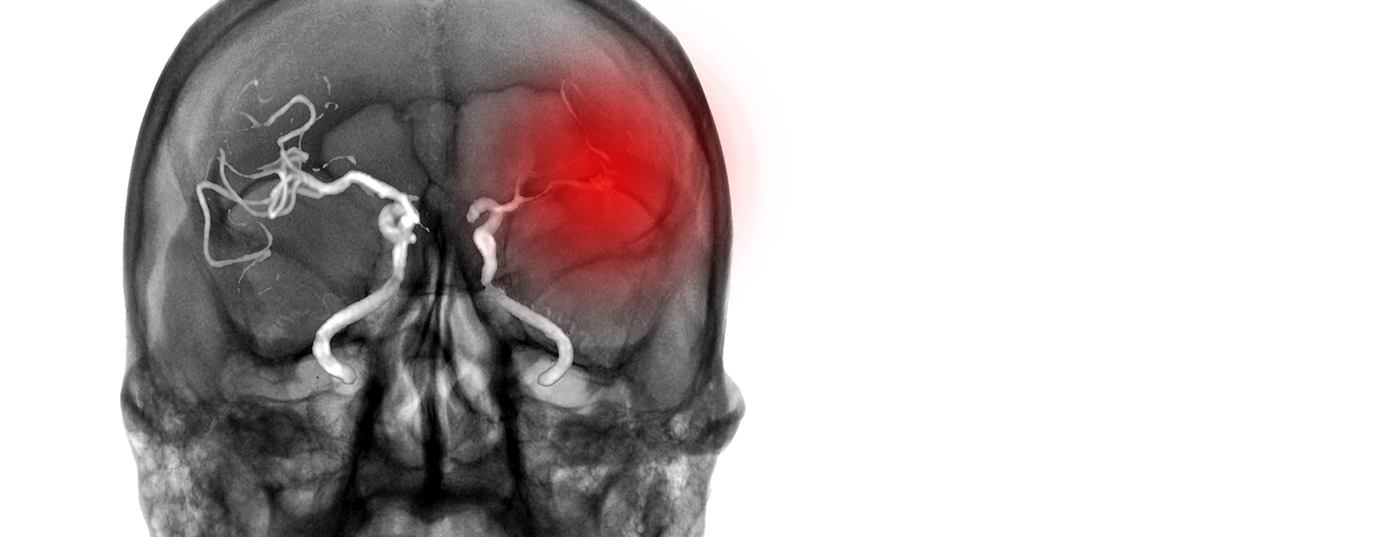For the treatment of acute stroke caused by a vascular occlusion or clot in the brain, “time is brain” applies – i.e. any loss of time must be avoided. The use of special ambulances (mobile stroke units) provides very good results here, since the diagnosis is confirmed “on site” by means of CT and clot-dissolving thrombolysis treatment can be started. The TASTE-A study [1] now suggests for the first time additional advantages of the substance tenecteplase over alteplase.
In Germany, 270 000 people suffer a stroke every year [2]. In the majority of cases, these are so-called ischemic strokes – i.e. an area of the brain is no longer (sufficiently) supplied with blood. Treatment aims to restore blood flow as quickly as possible so that brain cells in the affected region are not permanently damaged by ischemia and there is no permanent disability “time is brain”). Drug-induced dissolution of the clots via the bloodstream (systemic thrombolysis, or lysis for short) should be performed no later than 4.5 hours after the onset of symptoms.
In some countries, also in various German cities such as Berlin, there are specialized ambulances, so-called stroke-mobiles or mobile stroke units (MSU), which are equipped with a CT device to ensure the diagnosis already on site with adequate imaging and to be able to start thrombolysis without loss of time. The standard drug for thrombolysis is alteplase, a genetically engineered fibrinolytic (recombinant tissue-type plasminogen activator (rtPA).
The compound tenecteplase (TNK-t-PA) is a modified molecule with greater fibrin specificity and longer half-life, potentially improving reperfusion and clinical outcome. Another advantage of the substance, especially for use in the stroke mobile or also for emergency transfers between hospitals, is the one-time bolus administration. Alteplase, on the other hand, is administered as an infusion over one hour. Tenecteplase has been used in the treatment of myocardial infarction for more than 20 years; however, comparative data are still lacking for stroke treatment. Currently, tenecteplase is not approved for the treatment of stroke in Germany.
The Phase 2 randomized controlled trial TASTE-A (“Tenecteplase versus Alteplase for Stroke Thrombolysis Evaluation Trial in the Ambulance”) [1] from Australia now compared the use of both substances after CT in the mobile stroke unit with regard to very early cerebral reperfusion on arrival at the hospital. Five Melbourne hospitals participated. A total of 104 patients (≥18 years) reached by an MSU within the 4.5-hour time window after symptom onset could be included and analyzed after confirmation of ischemic stroke and if eligible for thrombolysis. On departure to the hospital, they received either weight-adjusted standard dose of alteplase (0.9 mg/kg, maximum 90 mg, 10% administered as a bolus i.v. over 1 minute and subsequently 90% administered as a 1-hour infusion) or tenecteplase (0.25 mg/kg, maximum 25 mg, administered as an i.v. bolus over 10 seconds). The primary outcome was the extent or volume of the cerebral lesion (i.e., the nonperfused or underperfused brain area) on perfusion CT on arrival at the hospital. Secondary outcomes included change in symptomatology or change in National Institutes of Health Stroke Scale ( NIHSS) score from MSU arrival to hospital admission and, in the long-term, poor functional outcome or death within 90 days (mRS score 5-6). Safety outcome also included symptomatic intracerebral hemorrhage and bleeding of any type within 36 hours. Although the study was basically an open-label study, the physicians who took over the patients in the clinic and followed up the clinical course were not informed which drug the patients had received.
As a result, between June 2019 and November 2021, 55 of a total of 104 affected individuals received tenecteplase and 49 received alteplase. The median age was 73 years (IQR 61-83), and the median NIHSS score was 8 (IQR 5-14), corresponding to a moderately severe stroke. The median time from start of treatment to arrival at the clinic was 47 minutes.
On arrival at the clinic, sufferers in the tenecteplase group had significantly less perfusion injury than those with alteplase (median 12 ml [IQR 3–28] vs. 35 ml [18–76]; p=0.003). The median NIHSS score had improved to 5 (3-11) on arrival at the clinic after tenecteplase versus 6 (2-16) after alteplase. At 90 days, 8/55 subjects (15%) receiving tenecteplase and 10/49 subjects (20%) receiving alteplase had an unfavorable outcome (mRS score 5-6; adjusted OR 0.7; statistically but not significant; p=0.45). There were five deaths in each of the two groups (p=0.88). Serious side effects and adverse events occurred in 5/55 (5%) in the tenecteplase group and 8/49 (8%) in the alteplase group. There were no symptomatic intracerebral hemorrhages within 36 hours.
“The study not only showed the advantage of starting lysis therapy already in the stroke mobile, but also suggests for the first time a superiority of tenecteplase over alteplase in terms of clinical outcome,” said Prof. Heinrich Audebert, MD, head of the mobile stroke unit project in Berlin. “The substance may be more effective. However, the advantage may also be due to the bolus administration. This means the drug is completely in the bloodstream more quickly than with infusion of the conventional drug. This shows that we need to exhaust every possibility to minimize the time between symptom onset and when the clot-busting drugs start working in the body.”
Literature:
[1] Bivard A, Zhao H, Churilov L et al. Comparison of tenecteplase with alteplase for the early treatment of ischaemic stroke in the Melbourne Mobile Stroke Unit (TASTE-A): a phase 2, randomised, open-label trial. Lancet Neurol 2022 Jun; 21 (6): 520-527 doi: 10.1016/S1474-4422(22)00171-5. epub 2022 May 4.
[2] Ringleb P., Köhrmann M., Jansen O., et al: Acute therapy of ischemic stroke, S2e guideline, 2021, in: German Society of Neurology (ed.), Guidelines for diagnosis and therapy in neurology. Online: www.dgn.org/leitlinien (accessed June 29, 2022).
Original publication:
doi: 10.1016/S1474-4422(22)00171-5.











